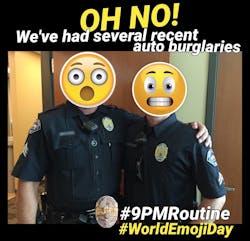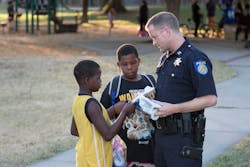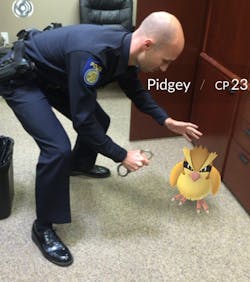Social media touches everything including modern public safety. Agencies throughout the nation use Facebook, Twitter, YouTube, Facebook Live, Periscope, Nextdoor and a variety of mobile applications to connect with their communities. Because of the influx of agencies on the web and the issues created by this, the International Association of Chiefs of Police (IACP) developed the Center for Social Media in 2009. This division assists agencies design policies and procedures allowing them to utilize social media while protecting themselves. In jumping on the social media train, agencies found they can use it to employ successful crime prevention methods.
#9PMRoutine
“And now for the main event! It’s time to lock up for the #9PMRoutine!” Pasco County Sheriff’s Office (Fla.) pushed out these words on Twitter and Facebook. “The sheriff decided our social media was something we needed to have more of a focus on,” explains Chase Daniels, assistant executive director, Pasco County SO. “At the time we had a Twitter following of about 9,000 and a Facebook following of 40,000 people. We were sitting in his office talking about how we can have a positive impact.” The department was in the middle of an unlocked auto burglary spree with several new reports each night. They came up with the idea of reminding people to lock their houses and cars every evening and realized their social media platforms were the ideal place for this reminder. “I think it speaks to Twitter as a whole, especially at night,” Daniels explains. “After they’ve been at work all day, homework is done and the kids are in bed, they are looking for something entertaining and fun. It’s fun to be part of something.”From January to May 2017, Pasco’s unlocked auto burglaries went down 33 percent and no other factor could be identified for the decrease. #9PMRoutine was working. Other agencies began reaching out to Pasco asking if they could replicate the social media trend and Pasco happily shared its strategy. So far, 25 additional agencies across the nation, including others in Florida, as well as ones in Idaho, Nevada, New York and Ohio have joined. Even a Canadian department is online with #9PMRoutine now. The strategy has also brought officers and community members closer. “We’ve had more than a few personal stories of people coming up to our officers and saying, ‘Hey, you work for Pasco County and you do 9PM. We love it’,’’ Daniels says. “The people feel they know the officers. It makes our officers feel a more connected part of our community and the community feel more connected with our department.”
A community of neighbors
Along with Pasco, Sacramento Police Department (Calif.) also found social media to be a successful part of their crime prevention effort. “Our social media use started in 2009 with Facebook and Twitter,” explains Jena Swafford, social media manager at the Sacramento Police Department. “We were fairly early adopters. We’ve continued to evolve the way that we use it. Currently, each platform has their own more specific use. Twitter is the place where you go to find the most real-time stuff. If our PIOs go out on a call, we’re tweeting about it. A critical incident? We’re tweeting about it and using the urgent incident on Nextdoor. We’re trying to reach the biggest audience we can.”
As far as crime prevention itself, Sacramento PD has a two-fold approach. First, they build their relationship with the community by making a connection through social media. Second, they use their connection to share information back and forth. “Making the connection with the community in the first place does a lot to establish those relationships that may or may not have been there before,” Swafford explains. “So they have an avenue to come to. When we get them coming, their feeds are more apt to see ours when we push information out.” Use of Nextdoor has been hugely successful for them.
The idea of being on Nextdoor came to Sacramento PD from the community itself. “There were 1,500 users on Nextdoor already talking to their neighbors,” says Swafford. “It tied in with the new chief’s philosophy of policing Sacramento by area. At that time, it was 1,500 people we might not have been reaching. It was a win-win and grew from there.” Nextdoor is unique because it requires a neighbor to register with their actual name and a verifiable address in the neighborhood. Public safety agencies can register as well but Nextdoor protects privacy and builds community trust by having a neighbor side and a police side only allowing police to see certain information. Sacramento PD helped pilot the new feature where users can flag the police in a post. They can then see the information in the post and dialogue with the neighbors referencing it. “We’ve been getting information from the community in their day-to-day posts,” Swafford states. “They can flag us and I get those messages. It gives me an opportunity to educate them on what their resources are if something happens in their neighborhood. Maybe they flagged us but thought it wasn’t a big deal. I can tell them next time call 911 or contact the court for a restraining order. It gives them one-on-one attention which surprises them but gives the department the chance to educate them.”
A virtual community watch
Using Nextdoor not only increased community connection with public safety, but also between community members. During Neighborhood Watch meetings, most of the hands go up when asked who heard about the meeting on Nextdoor. “Over time, we continue to hear, ‘I heard about this on Nextdoor,’” says Swafford. “It’s been described as a virtual Neighborhood Watch. A lot of people will say they met on Nextdoor and this is the first time they’ve met in person. Our whole point is to get people to know each other and care about each other.”
Around 80,000 members are registered in Sacramento’s 160 Nextdoor neighborhoods and it continues to grow. It has contributed to a reduction in crime in Sacramento. From 2013 to 2014, the city saw a 15.6 percent reduction in Part 1 crimes. The numbers continue to drop. In 2016, the city saw a burglary rate decrease of 17.5 percent. “We’ve continued to grow our social media here and it’s a testament to our commitment to community engagement and social media playing a huge role in lowering crime with them being more active and engaged in their community,” explains Swafford. Sacramento PD currently has 100,000 Twitter followers, 26,194 on Facebook and 742 on their YouTube channel. Sacramento continues to explore how to use the new live video feeds in an effective manner including releasing in car and body worn video.
Direct to consumer approach
“Twitter, Facebook, Instagram, YouTube, Periscope and Facebook Live, we use all of them,” says Detective Jeremy Silbert, PIO, Baltimore Police Department (Md.). They use them all with the same general idea—communicating directly with the community. “It’s the direct to consumer approach like the corporate world,” he explains. “We’re always looking for new and creative ideas for how we can push information out to the community. It’s very important for the community to reach out to us also.”
The newest thing for Baltimore is their Baltimore PD Mobile app available for free on iPhone and Android. Users can do any number of things from reporting a crime to locating the closest police station. “It links back to the city app, so you can even pay your water bill,” explains Silbert. “It’s all about policing community. We can’t do our job without the community being involved.”
Keeping it fresh
Agencies who use social media are finding it extremely useful during critical incidents and natural disasters. “We embedded one of our social media coordinators with our PIO at the EOC,” Daniels explains of Hurricane Irma. “We pushed out real-time information that we would get, like be aware of fraud, secure your lawn furniture, etc. We calculate the storm period lasted eight to nine days and we had a reach of 24.9 million. The county was only at 300,000. This speaks for #9PMRoutine. If you only push out information when you have something to put out and you don’t engage, you don’t become the agency the community is looking for. The community has come to expect to engage with us.”
Hurricane Harvey was another good example. “During Hurricane Harvey, Nextdoor played a big role in that community as far as people getting information out,” says Swafford. “Social media and disasters have been increasing because cellphones aren’t working but internet is.”
With so much going on and so much information being pushed out, how do public safety agencies keep themselves fresh, relevant and not lost in the fray? “The fact is it’s something we do every night,” Daniels explains. “Even during Hurricane Irma, we had people asking us if we were going to be doing this every night. Twitter becomes so negative. #9PMRoutine is positive and refreshing and fun. It’s a nice break.”
Swafford agrees. “Some of that comes back to spending every day on it,” she says. “If you’re not posting every day on your platforms, in one way or another, you’re not going to get that engagement. It’s based on an algorithm. If you’re not talking, they’re not apt to come looking for something.” This consistency makes community members trust they can go straight to the agency for their information. “We want people coming to us to find out what’s going on in our city,” explains Swafford. “It cuts down on 911 calls and inquiry calls.”
She also encourages agencies to stay on top of trends. “Right now it’s the clown and IT trend,” she states. “Combining your humor with something serious seems to be the most successful campaign. That’s what keeps it more fun and if it’s more fun, people are going to stay interested.” Currently, live video is becoming more popular. “There is a human side to live video,” Swafford says. “It hasn’t been edited. There aren’t outtakes. It helps in crime prevention by making them see we are people and we want to help people. If the community feels comfortable coming to us, they are going to come to us when something happens because we can’t be everywhere like they are.”
What it takes
Swafford states social media is her full time job. Her advice for small agencies: start with Nextdoor because it’s your community. “It’s important to get their brand out,” she says. “If you’re starting small, talking to your community, your neighbors is very important and a great place to start. It’s not as uncomfortable, scary and overwhelming as you think.”
Don’t forget social media. “It still shocks me the amount of agencies that don’t have a social media presence or it’s negative,” Daniels says. “Keeping it lighthearted and fun and having a positive message that serves your end goals can’t be overstated. Don’t forget that it’s social. It’s engagement.”
Social media engagement doesn’t have to only come from the information office. “Several of our commanders, including our police commissioner have personal Twitter accounts to help disseminate information as well. Not just the PIO,” Silbert explains of their total social media philosophy. “It’s to humanize ourselves. You might see us on TV but at the end of the day we’re people also. It’s about the relationship building.” And every agency can “like” having community relationships, especially in this technological age.
About the Author: Michelle Perin has been a freelance writer since 2000. She earned her Master’s degree in Criminology and Criminal Justice from Indiana State University.

Michelle Perin
Michelle Perin has been a freelance writer since 2000. In December 2010, she earned her Master’s degree in Criminology and Criminal Justice from Indiana State University.







